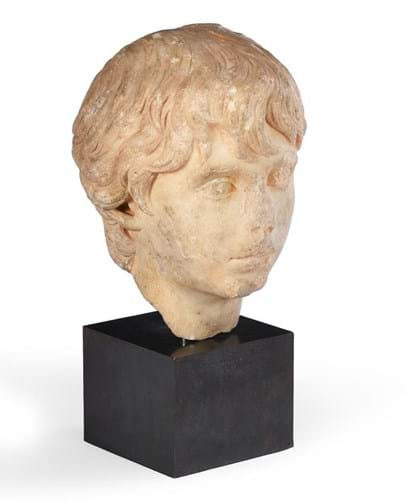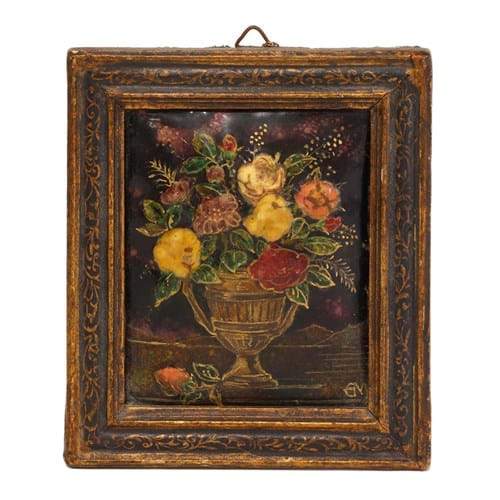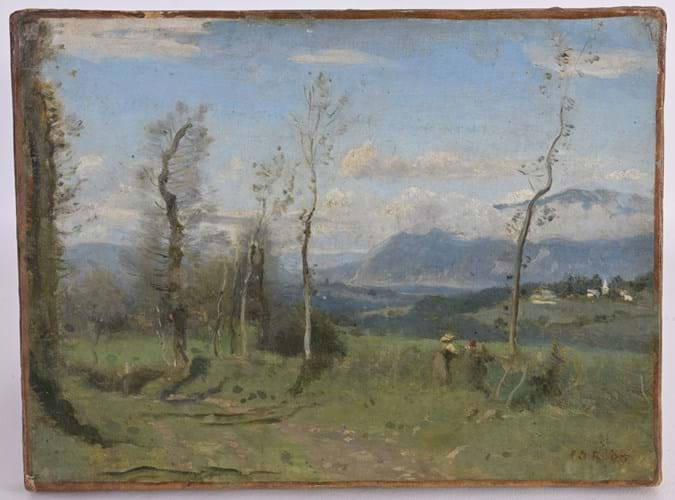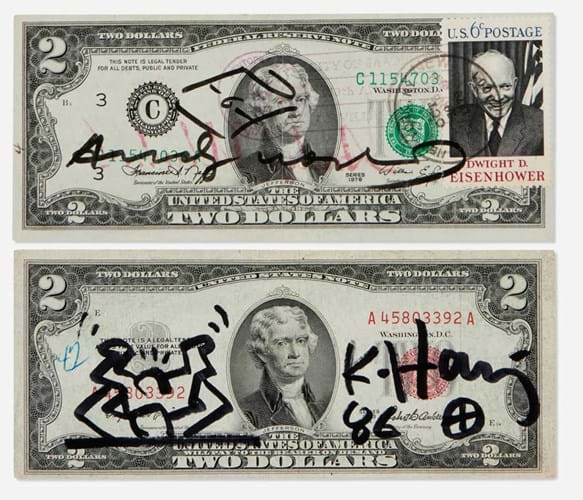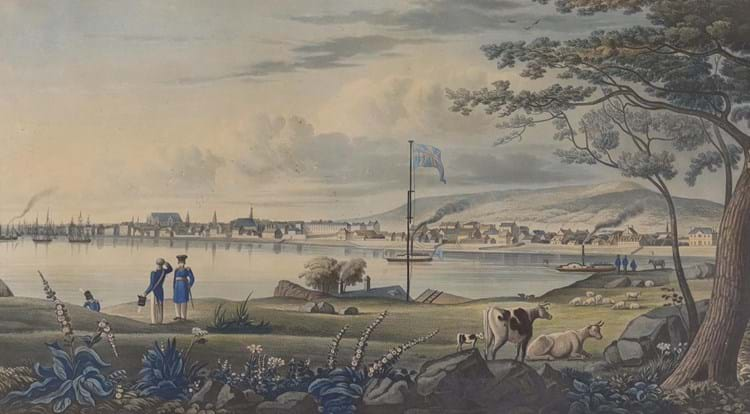
Montreal from St Helen’s Island, one of five framed Gray and Gleadah prints of Canada sold for £8500 at Gorringe’s.
1. Prints of Canada – £8500
Estimated at £300-500, a group of five hand-coloured prints of early 19th century Canada sold for £8500 at Gorringe’s in Lewes on August 14.
Although the titles were covered by mounts to the frames, the views offered here were those engraved by Joshua Gleadah after drawings by James Gray. The five plates were General View of the Falls of Niagara from the British Shore, A View of Brockville, Upper Canada, from Umbrella Island, Montreal from St Helen’s Island and York from Gibralter Point, Kingston from Fort Henery.
The so-called Gray and Gleadah prints of Canada were a favourite of F St George Spendlove, curator at the Royal Ontario Museum, whose 1958 book The Face of Early Canada remains a key reference work on the subject. He wrote: “In the year 1828 seven coloured aquatints of Canada from drawings by James Gray were engraved by Joshua Gleadah and J. Ryall. They were published by Willett & Blandford, London, and dedicated to Sir Peregrine Maitland, Lieutenant Governor, and the Gentlemen of Upper Canada. The set is of extreme rarity and…in a class by themselves in the Canadian field.”
When Spendlove was writing he knew of only two sets of seven engravings. In addition to the five plates mentioned above he added Quebec, from Point Levi and Horse Shoe Fall of the Falls of Niagara from the Upper Bank of the British Shore.
However, the copy of Gray and Gleadah prints that emerged for sale as part of the famous Winkworth trove of Canadiana at Christie’s King Street in April 2015 had eight prints – the previously unknown plate titled Falls of Montmorenci from the east bank.
This apparently unique set, sold at the time for £42,000 and reappeared for sale this year as part of the Norman Bobins sale at Christie’s New York on June 16 where, estimated at $30,000-50,000, it took $65,000.
2. Roman marble head – £35,000
This carved marble portrait head of a youth is Roman and dates from a tightly dated period of the 2nd century. The subject is thought to be Polydeuce, the pupil of the wealthy politician and philosopher Herodes Atticus (101-177 AD).
It is usually understood that the two had a love affair and, when Polydeuce died in 173-174, Herodes began a process of very public grieving, erecting statues and monuments to his pupil and encouraged his veneration as a hero. Hadrian had treated his beloved Antinous in much the same way.
Another portrait bust of Polydeuce is in the Sir John Soane’s Museum. This example, measuring 11in (28cm) high, came for sale at Dreweatts in Newbury on August 15 as part of a consignment from the interior decorator Anouska Hempel. It had been at her home, Shaw House in Wiltshire, since she purchased it in the 1980s from the London dealership Mallet.
Among the best performing items in the 214-lot sale, it was guided at £3000-5000 but hammered at £35,000.
3. Historic royal pardon – £1400
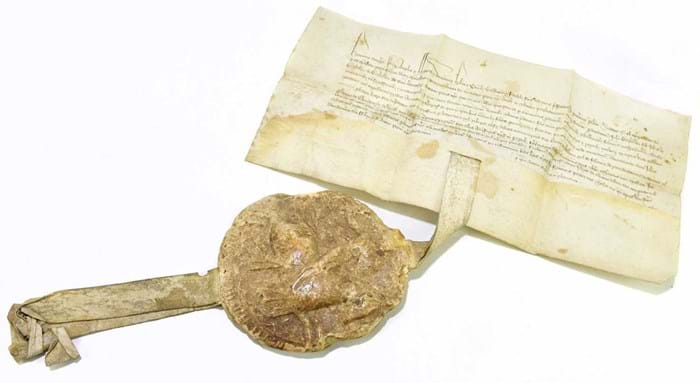
A royal pardon issued by Henry IV to John Barlawe of the manor of Barlow, Chorlton-Cum-Hardy, £1400 at Adam Partridge.
This medieval document with a royal seal attached amounts to a pardon granted Henry IV (1367-1413) to John Barlawe of the manor of Barlow in Chorlton-Cum-Hardy (now suburban Manchester).
His crimes are not specified but the text reads that Barlawe be “forgiven all rebellion and insurrection against the crown, all homicide, felony, robbery and participation with such". It is thought to date from 1412, the penultimate year of Henry IV’s rule.
An object of obvious local interest to the clients of Cheshire auctioneer Adam Partridge, it sold for £1400 (estimate £400-600) as part of a three-day sale on August 16-18.
Henry spent much of his tumultuous reign defending himself against plots, rebellions, and assassination attempts. His key issue was what to do with the recently deposed Richard II and how to persuade his subjects that, previously simply Henry Bolingbrooke, aristocratic son of John of John of Gaunt, he was now kingship material.
Even when Richard died in prison and his body was put on show at the old St Paul’s Cathedral, rumours circulated that he was still alive and waiting to take back his throne.
4. Enamel panel – £2050
A Sworders timed online sale that closed on August 13 included this rare enamel by Ernestine Evans Mills (1871-1959). She is known today as an artist, metalworker and enameller in the Arts and Crafts tradition but also for her links to the suffragettes.
As a friend of Emmeline Pankhurst and a champion of women's rights, she was seen as an integral part of the movement.
Three pieces of jewellery made by the artist during this period, including a Votes for Women brooch, can be found in the Museum of London plus a commemorative plaque for the Brackenbury women, Hilda, Georgina, and Marie.
This 4.75 x 4.25in (12 x 11cm) panel of an urn of flowers in an artist-painted frame was guided at £300-400 but took £2050.
5. Corot landscape – $31,000
This unframed 8 x 11in (20 x 28cm) oil sketch of the Swiss village of Dardagny is signed for Jean-Baptiste-Camille Corot (1796-1875). At Helmuth Stone Gallery in Sarasota, Florida on August 6, it more than doubled the top estimate to bring $31,000/£24,800 (plus 25% buyer’s premium).
Corot was a tireless traveller. For much of his working life he would spend his summers on the move, making studies and sketches, and his winters finishing more polished, market-ready works in the studio.
In his later years he was an enthusiastic patron of the emerging rail network.
The extension of the network of French railroads in the 1850s and 60s widened the range of his subject matter in his later years and he painted in Switzerland many times. He visited Dardagny, a small village west of Geneva, on three occasions in 1852, 1857 and 1863.
This tranquil summer scene of trees and pasture with the lavender blue hills of the Jura in the distance depicts an area now best known for its winemaking. It was sold as an autograph work.
The strong market for Corot's works in North America in the 19th century ensures many of his works still reside in US collections. However, it also resulted in a huge number of Corot forgeries. The French art historian Rene Huyghe famously quipped that “Corot painted 3000 canvases, 10,000 of which have been sold in America”.
6. Signed two-dollar bills – $4500
This pair of two-dollar bills were worth a lot more than a couple of bucks. Chicago-based auction house Wright sold them for $4500 (£3600) on August 9.
The reasons for the competition way above the estimate of $500-600 were the marker pen signatures of two of America’s best known 20th century artists.
Keith Haring had signed one note in 1986 with a trademark figural doodle in black ink. Andy Warhol had signed another front and back, stamped it with a Campbell’s soup can print and seemingly mailed it with a Six Cent Eisenhower stamp postmarked for October 28, 1979.


